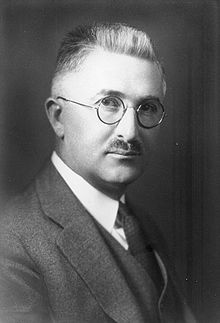Ralph Hartley
| Ralph Hartley | |
|---|---|
 |
|
| Born |
November 30, 1888 Spruce, Nevada, U.S. |
| Died | May 1, 1970 (aged 81) Summit, New Jersey, U.S. |
| Residence | United States |
| Nationality | American |
| Fields | Electrical engineering |
| Alma mater |
University of Utah Oxford University |
| Notable awards | IEEE Medal of Honor (1946) |
Ralph Vinton Lyon Hartley (November 30, 1888 – May 1, 1970) was an electronics researcher. He invented the Hartley oscillator and the Hartley transform, and contributed to the foundations of information theory.
Hartley was born in Sprucemont, Nevada and attended the University of Utah, receiving an A.B. degree in 1909. He became a Rhodes Scholar at St Johns, Oxford University, in 1910 and received a B.A. degree in 1912 and a B.Sc. degree in 1913. He married Florence Vail of Brooklyn on March 21, 1916. The Hartleys had no children.
He returned to the United States and was employed at the Research Laboratory of the Western Electric Company. In 1915 he was in charge of radio receiver development for the Bell System transatlantic radiotelephone tests. For this he developed the Hartley oscillator and also a neutralizing circuit to eliminate triode singing resulting from internal coupling. A patent for the oscillator was filed on June 1, 1915 and awarded on October 26, 1920.
During World War I Hartley established the principles that led to sound-type directional finders.
Following the war he returned to Western Electric. He later worked at Bell Laboratories. He performed research on repeaters and voice and carrier transmission and formulated the law "that the total amount of information that can be transmitted is proportional to frequency range transmitted and the time of the transmission." His 1928 paper is considered as "the single most important prerequisite" for Shannon's theory of information. After about 10 years of illness he returned to Bell Labs in 1939 as a consultant.
...
Wikipedia
